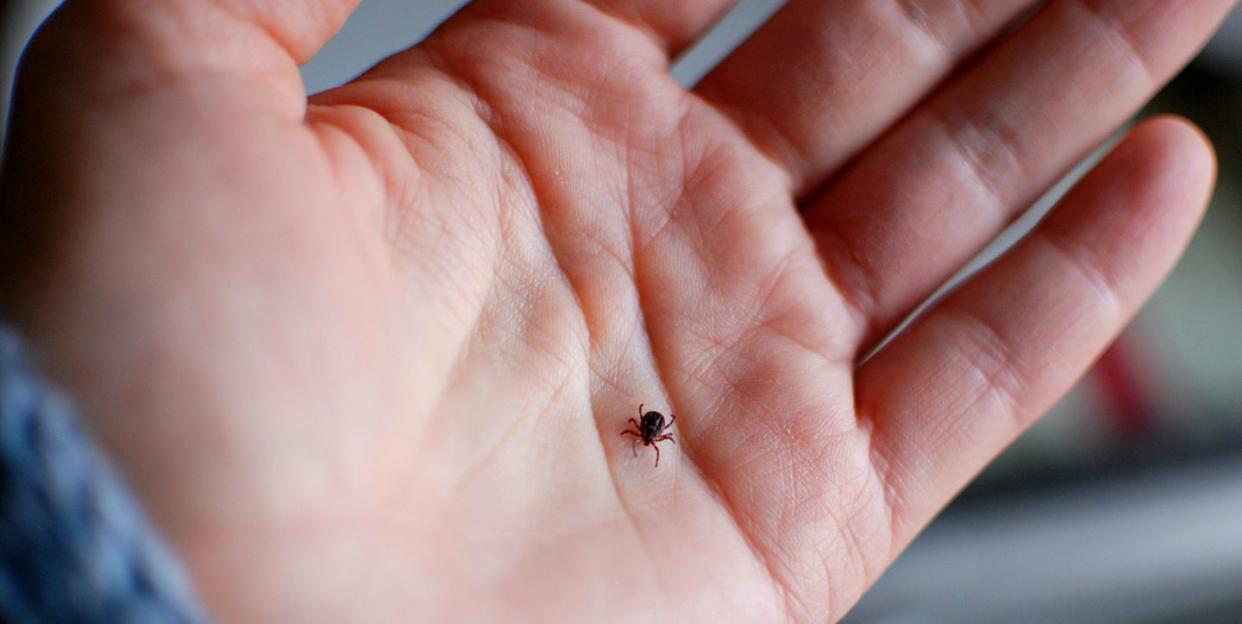The Right Way to Get Rid of Ticks

Ticks are most prevalent from April through October, and experts warn that bug populations are rising this year.
Even if you're in an urban area, you can get tick bites.
You can prevent tick bites if you take the right steps.
As warm weather invites people outdoors, it also invites an explosion of ticks—which also means an explosion of ticks—which also means an explosion of tick-borne diseases, the most famous of which is Lyme disease.
Though tick populations are active from April through October, they tend to rise in the summer, and numbers this year are expected to be higher than previous seasons. The Department of Health in Rhode Island, for instance, warns that 2020 may be a bad year for tick bites, since the mild winter may mean that more ticks than usual have survived until spring.
The CDC says ticks and tick-borne diseases are "distinctly on the increase in the U.S.," which means you should distinctly increase your efforts to keep them from biting you, as they can cause a host of diseases including Lyme disease, Rocky Mountain Spotted Fever, Erlichosis, Tularemia, allergies to meat, and many more—none of which you want to get, trust us. So it's important to know how to get rid of ticks in the event that you get bitten, and how to keep them away from you in the first place.
It's especially important right now, because according to the CDC report" there's no question that every year will be a bad year for Lyme disease in the northeastern region." But ticks and tick problems aren't just limited there. Ticks of all types have been expanding their geographic range—they can be a problem now in every region of the U.S.
To make matters worse, while we typically think that ticks tend to be concentrated in rural, woody areas, Kayla Socarras, a microbiology researcher at Drexel University College of Medicine in Philadelphia, Penn., but they're even prevalent in suburban back yards.
There are a number of strategies that help you get rid of ticks the right way. And at the top of the list is to keep them from getting on you in the first place. But if they do end up attached to you, it's essential to know the right way to rid them from your body. Killing ticks in your yard is a little tougher, but here's what to know about all the best get-rid-of-ticks strategies:
1) Get rid of ticks by keeping them off you.
After months of enduring heavy coats and bulky sweaters, the last thing you want is to hide under more layers of clothes. But Socarras says long-sleeved shirts and pants are the best way to keep ticks from getting onto your skin and biting you. (Tuck your pants into your socks and your shirt into your pants.) Ticks won't be able to climb up clothes for very long that have been treated with the repellent permethrin—this is one of the most effective ways to keep ticks off you, but you need to think ahead. This repellent needs to dry on your clothes, so you'll want to spritz them at least the night before (and then it lasts for about six washings or about six weeks). If you have exposed skin, you'll need a different type of repellent, explains Dr. Michael Zimring of the Mercy Medical Center in Baltimore.

Look for formulas containing DEET, picaridin or oil of lemon eucalyptus to deter ticks, according to the Centers for Disease Control and Prevention.
Even if you follow every tick-fighting tip in the book, Socarras recommends thoroughly checking your skin for black spots after a trip outside. “Ticks are so small, people sometimes confuse them for a freckle,” she warns.
You should also hop in the shower to wash off and inspect your more, um, hidden regions. “They like moist areas, like the groin and under your arms,” Socarras says.
2) If a tick has bitten you, get rid of it very carefully.
If you find a tick embedded in your skin, then it's time to take out the pointy tweezers. Put rubbing alcohol on the area to sanitize it, grab the tick right where it meets your skin, and slowly and gently pull it out. "Pointy tweezers allow you to avoid squishing the abdomen and pushing germs back into your system, explains Jody Gangloff-Kaufmann, coordinator of community Integrated Pest Management at the New York State Integrated Pest Management Program. If you don't have pointy tweezers, use the angled type if you need to—"do the best with what you have," she says. Just try to avoid pulling it out with your fingers, which will likely squeeze the abdomen and cause a germ dump right into you.
Whatever you do, don't hold a cigarette or match behind it (find out more about why that's a bad idea here).
You can kill the tick by dropping it in a jar that contains alcohol. But don't toss it! Save the tick so your doctor can see exactly what bit you. That will help them figure out what's going on in your body should you have symptoms of a tick-borne disease, since different ticks tend to carry different diseases. (If they're not sure, check out this chart and the many other excellent tick resources at the University of Rhode Island's TickEncounter site.)
3) Get rid of ticks in your environment.
Controlling ticks in your yard sounds like a great idea, but it's challenging. Animals generally bring the ticks to your yard, so the key to tick control is actually animal control. And anyone with frequent deer visits knows that unless you put up deer fencing, it's hard to keep them out of your yard without a large-scale effort to keep them out of your whole neighborhood.
But you can try to make your yard as inhospitable to ticks and the animals that carry them as possible. Keep your grass trimmed, clear away cuttings, and consider making some kind of dry mulch barrier between you and the woods if your lot backs up to a forested area. Just be aware that doing this kind of work to keep your yard clear can also expose you to ticks, so don't go out unprotected.
You Might Also Like

